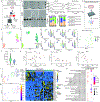Autofluorescence is a biomarker of neural stem cell activation state
- PMID: 38521057
- PMCID: PMC10997463
- DOI: 10.1016/j.stem.2024.02.011
Autofluorescence is a biomarker of neural stem cell activation state
Abstract
Neural stem cells (NSCs) must exit quiescence to produce neurons; however, our understanding of this process remains constrained by the technical limitations of current technologies. Fluorescence lifetime imaging (FLIM) of autofluorescent metabolic cofactors has been used in other cell types to study shifts in cell states driven by metabolic remodeling that change the optical properties of these endogenous fluorophores. Using this non-destructive, live-cell, and label-free strategy, we found that quiescent NSCs (qNSCs) and activated NSCs (aNSCs) have unique autofluorescence profiles. Specifically, qNSCs display an enrichment of autofluorescence localizing to a subset of lysosomes, which can be used as a graded marker of NSC quiescence to predict cell behavior at single-cell resolution. Coupling autofluorescence imaging with single-cell RNA sequencing, we provide resources revealing transcriptional features linked to deep quiescence and rapid NSC activation. Together, we describe an approach for tracking mouse NSC activation state and expand our understanding of adult neurogenesis.
Keywords: FLIM; NAD(P)H; activation; adult neurogenesis; autofluorescence; fluorescence lifetime imaging; intrinsic fluorescence; lysosomes; neural stem cells; quiescence.
Copyright © 2024 Elsevier Inc. All rights reserved.
Conflict of interest statement
Declaration of interests The authors declare no competing interests.
Figures




References
-
- Lugert S, Basak O, Knuckles P, Haussler U, Fabel K, Gotz M, Haas CA, Kempermann G, Taylor V, and Giachino C (2010). Quiescent and active hippocampal neural stem cells with distinct morphologies respond selectively to physiological and pathological stimuli and aging. Cell Stem Cell 6, 445–456. 10.1016/j.stem.2010.03.017. - DOI - PubMed
-
- Harris L, Rigo P, Stiehl T, Gaber ZB, Austin SHL, Masdeu MDM, Edwards A, Urban N, Marciniak-Czochra A, and Guillemot F (2021). Coordinated changes in cellular behavior ensure the lifelong maintenance of the hippocampal stem cell population. Cell Stem Cell 28, 863–876 e866. 10.1016/j.stem.2021.01.003. - DOI - PMC - PubMed
MeSH terms
Substances
Grants and funding
LinkOut - more resources
Full Text Sources
Molecular Biology Databases

